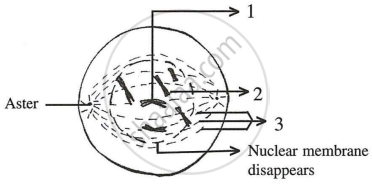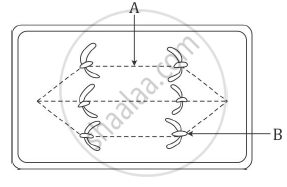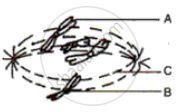Advertisements
Advertisements
प्रश्न
Given below is a diagram representing a stage during mitotic cell division in an animal cell Examine it carefully and answer the questions which follow.

- Identify the stage. Give one reason in support of your answer.
- Name the cell organelle that forms the ‘aster’.
- Name the parts labelled 1, 2 and 3.
- Name the stage that follows the one shown above; how is that stage identified?
- Mention two differences between mitosis and meiosis with regards to:
- The number of daughter cells produced.
- The chromosome number in the daughter cells.
उत्तर
- Prophase: The nuclear membrane disappears.
- Centrioles
-
- Centromere
- Sister chromatids.
- Spindle fibre.
- Metaphase: The centromeres of chromosomes are drawn to the equator by the equal pull of two chromosomal spindle fibres that connect each centromere to the opposite poles.
forming a metaphasic plate. -
- Mitosis:
- Two daughter cells are produced.
- The number of chromosomes is the same as that of the parent cell.
- Meiosis:
- Four daughter cells are produced.
- Half the number of chromosomes as that of the parent cell.
- Mitosis:
APPEARS IN
संबंधित प्रश्न
The diagram given below represents a certain stage of mitosis:

- Identify the stage of cell division.
- Name the parts labelled A and B.
- What is the unique feature observed in this stage?
- How many daughter cells are formed from this type of cell division?
The fig given alongside shows a certain stage in a cell division in a cell with four chromosomes.

(i) Name the parts of the chromosome labeled A and B.
(ii) Name the structure C. what is its function?
(iii) Name the type of division . Give a reason.
(iv) Name the stage of division.
(v) Name the stages before and after the stage shown in diagram.
Explain the Term Pachytene
Name the Following
The stage when chromosomes arrange at the equator.
Name the Following
Name the stage during which nuclear membrane and nucleoli reappear.
Name the Following
Nuclear envelope and nucleoli reappear in which stage.
Give Technical Terms
Division of nucleus.
Mention, if the following statement is True or False. If false rewrite the wrong statement in its correct form:
The alkaloid colchicine inhibits the formation of the mitotic spindle.
Column ‘II’ is a list of items related to ideas in Column ‘I’. Match the terms in Column ‘II’ with a suitable idea given in Column ‘I’.
| Column I | Column II |
| (i) Anaphase | (a) Chromosomes become arranged in a horizontal plane at the equator. |
| (ii) Prophase | (b) Daughter chromosomes move to opposite poles of the spindle. |
| (iii) Telophase | (c) Chromosomes become visible as fine, long threads. |
| (iv) Metaphase | (d) Chromosomes lose their distinctiveness and gradually become transformed into chromatin network. |
